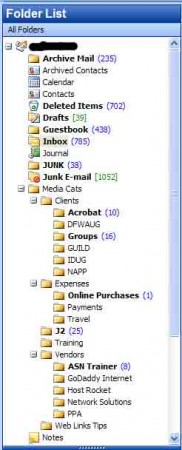
UPDATE 9/11/2017 – Added new items to consider since the Equifax data breach.
UPDATE 11/01/2013 – Many banks have discontinued their special ID Theft programs in favor of account alerts. Check with your bank for the monitoring programs they offer.
UPDATE 4/13/2010 – I referenced Lifelock in this post, and you should be aware that they have been part of class action lawsuits more than once since 2008. As I mentioned in my post, many of the services they offer you can do yourself. Bottom line, in this digital age you have to be ever vigilante with your personal information.
Chris Pirillo posed the question yesterday, “Do you protect yourself from identity theft?”
As a two-time victim of identity theft, I thought I would expand on the tips that he received via email:
1. Credit Reports – Get your free credit report from ALL THREE of the major credit reporting agencies – Equifax, Experian, and TransUnion via Annual Credit Report. Setup an annual reminder for these reports, and also spread them out rather than getting them all at the same time each year. I was surprised to learn that the three agencies had different information regarding my credit at the time my identity was stolen. Also consider a report from ChexSystems, which reports on checking/savings accounts in your name.
2. Credit Monitoring – Consider using free services such as Credit Karma, Credit Sesame, and Quizzle. Each has their benefits, e.g., Credit Karma includes reports from Equifax and Transunion, Credit Sesame includes identity theft insurance, there’s no reason not to sign up for all three. Your bank or credit card company may offer a service to monitor your credit reports. Most of these vendors will also give you copies of your credit reports as part of their service. American Express has Credit Secure, Bank of America has Privacy Assist, and Chase has Identity Protection.
3. Credit Protection – Rampant ID theft has created a new industry, and the front runner in protective services is LifeLock. The company offers a number of services, many of which you could do yourself, but <sarcasm>who has that kind of time?</sarcasm> They remove your name from many junk mail lists, put a “fraud alert” on your identity with all three credit reporting agencies (which only last 90 days), renew that alert for you, order your three credit reports each year, and help you contact all your banks, credit cards, etc., should your wallet ever be stolen. The advantage to using a service, “set it, and forget it.” You are paying for their service, everything offered you could do yourself for free if you choose.
4. Credit Insurance – Check with your insurance agent, or your bank. Many offer identity theft insurance. This is simply a service that helps you pay many of the legal fees associated with identity theft. It is not much in terms of money, but every bit helps.
5. Freeze Your Credit – there are debates about the security vs convenience of freezing your credit. If you do not have any immediate need to have credit for purchases such as a home, car, or need a new line of credit then a freeze probably makes sense. Know that you’ll receive a PIN number to help unfreeze your account. Know that you shouldn’t lose that PIN.
6. Secure your Social Security account – Yes, there’s an online window to your social security account. Best you login and secure it before someone decides to do that. https://www.ssa.gov/
7. Secure your IRS account – Tax fraud, i.e., someone filing a return as you to get a refund, has been on the uptick for the past few years. Do what you can to secure your IRS account. https://www.irs.gov/individuals/get-transcript
8. Get a Google Voice number – Consider a Google Voice number for securing accounts instead of your cell phone, especially if you use text/voice two-factor authentication. If you don’t already have a GV number the upside is you can use it ONLY for your bank and credit accounts. Less likely to be spoofed like an actual cell number.
9. Secure your cell phone account – while not fool-proof, adding a PIN to your cellular account is helpful in thwarting attempts to access by identity thieves. In some cases you can turn off online access to accounts, which while inconvenient means potential threats have to be done in-person at a retail location.
10. Use a password manager – If you’re not already using a password manager then consider 2017 your year to upgrade. Plenty of options to choose from in another article I wrote about apps for non-technical folks.
But what happens if you still become victim of identity theft? Here are some things nobody told me:
1. File a Police Report – The moment you are aware of the ID theft, file a police report. This makes an official record of the event, which will only help you when talking to the bank or credit card agency to remove charges.
2. Put a Fraud Alert on Your Accounts – If you’re using a service such as LifeLock, this has already been done. If not, you can contact the three credit reporting agencies (see above) and enable the fraud alert. A fraud alert means any request for credit requires your written signature. This makes it harder (but not impossible) for someone to request credit via the Internet or over the phone. It also means more hoops for you to jump through when you are the one legitimately applying for the loan.
3. ICE Your Credit – CNN posted an article about Emergency Contacts back in February. The article had some information about the new ICE initiative. The basic idea is making emergency contact info readily available on your cell phone, and a free ICE website also provides laminated wallet emergency contact cards. I use a similar approach with my credit card info. I have a laminated wallet card with the phone numbers of all the accounts I would need to contact in case my identity is stolen. I do not keep this card in my wallet — it does me know good if I get robbed — instead I carry it separate in my pocket. I also have the numbers programed in my phone for access. The benefit of the laminated card? It’s water proof, doesn’t need batteries, and anyone can use it in the event I’m incapacitated. Oh, and I also carry an ICE card.
4. Don’t Blame The Internet – Despite what most people think, email & phishing scams are not the only sources of identity theft. I would say that they’re not even the largest sources. When I moved to Dallas, it was the number one city in the country for ID Theft. Some examples of how ID’s were stolen: mailbox theft, credit card skimming (using a device to record your credit card number), ATM decoys, and best of all companies that do not correctly secure or destroy personal records. In terms of ID Theft, Liz Pulliam Weston wrote an article suggesting we could learn something from Europeans.
If you’re not concerned about identity theft, you should be. Here’s a thought, it’s not the financial impact of identity theft that’s the potentially the most damaging, but the ability of someone to use your identity to commit a crime. Criminal Identity Theft does not go away overnight, and can follow you for years. Victims of Criminal ID Theft find themselves in constant struggle to prove their innocence. I could not find the original article, but I read years ago of a woman who had three official court documents for her state, and she still would occasionally end up in jail for warrants that were not her. (Apparently, Judges do not work on weekends.)
OK, if you’re a first time reader, then you can see I have a tendency to ramble on quite a bit. I hope the information proves useful to you, and you never find yourself in a position where $75k is spent on your company’s corporate account in your name.
I don’t normally ask, but please share this post if you found the information useful. Thank you.



